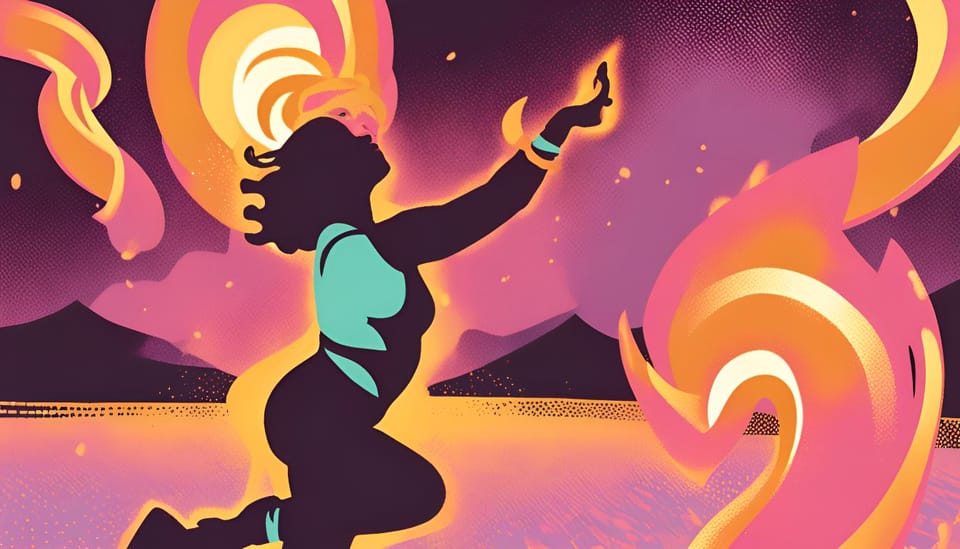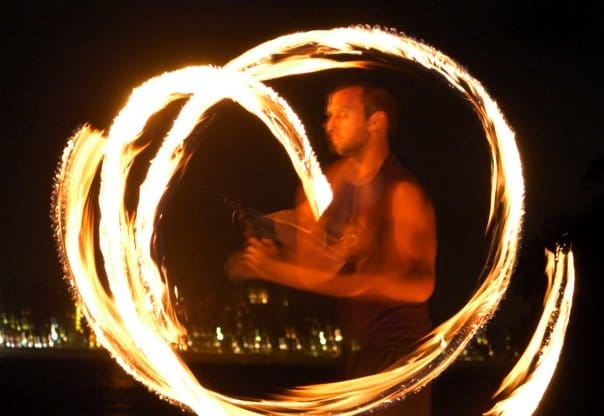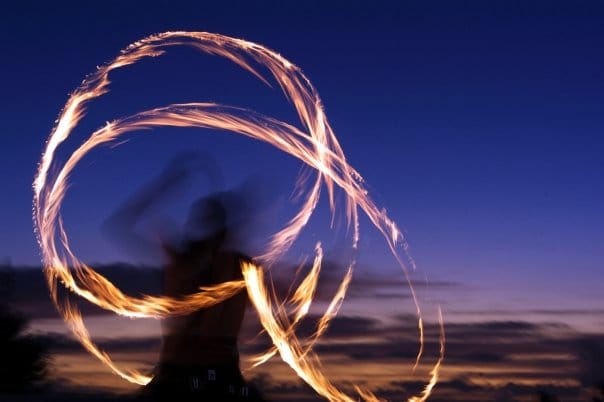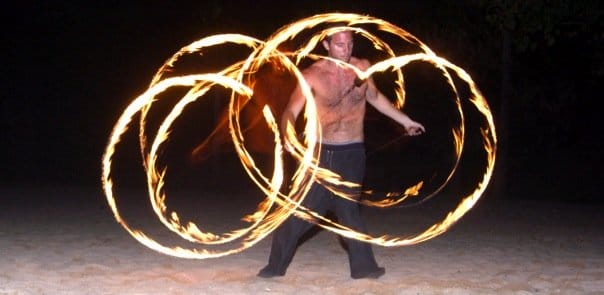Fire and Freedom Entrepreneurial Lessons from the Circus

Descending into the chaos of New York City, I couldn't help but whisper to myself, "This city truly never sleeps." But it all changed when I stepped into that bar. Not any ordinary bar, mind you - it was an old haunt with dim, flickering lights that barely lit the worn-out faces of dreamers like us, and the air heavy with the scent of cheap beer and cheaper dreams.
That's where I met Kasia. Her laughter cut through the noise—a clear, melodious sound, almost too pristine for the gritty backdrop of the bar. Over another round of crackling, bitter beer, she mused, "It's wild, Matteo, but isn't there a strange charm to it?" Yes, there was—New York was chaotic, magnetic, and undeniably alive.
Our nights together turned into a kaleidoscope of spontaneous adventures. We wandered from artsy hangouts in Williamsburg to secretive tattoo parlors that came alive at midnight. One night, drawn by whimsy and whiskey, we found ourselves in a buzzing tattoo shop at 3 AM, the needle buzzing a permanent memory into our skins.
Those nights we felt infinite––rousing street poets from their slumbers, sharing pizza slices on cold benches, and letting jazz wash over us in underground clubs. The world spun faster around us, every moment intensified like the city's glaring lights. We jumped from moment to moment, fueled by the daring promise of a tomorrow that never seemed to arrive.
Our romance was a blaze, burning brightly against the New York skyline. There were times when we merged into the rhythm of the city so completely, draped over each other in the back of some 24-hour diner, our conversations a blend of dreams and delirium. We danced through subway stations, our laughter echoing down empty corridors, and made love with a reckless abandon that felt like it could outshine the stars themselves.
But the reality of impermanence struck as Australia began tugging at Kasia’s soul, an adventure she felt compelled to embark on alone. The digital threads that bind us so effortlessly today were absent back then; messages took days, connections thinned. "Guess this is it, huh?" she said, packing her life into a few suitcases. Her excitement was palpable, but so was the dread.
Watching her prepare to leave, I felt a paralyzing blend of inevitability and desperation grip me. Her laughter, once a melody in the overture of our nights, now haunted our soon-to-be empty apartment like a ghost. In a city that never pauses, her absence carved out a sudden, gaping quiet that I didn't know how to fill.The day she left, the city felt colder, its colors less vivid, as if someone had dimmed the very lights of New York behind her.
Fueled by a restless desire to see the world, my decision to follow Kasia to Australia seemed like the perfect next step in my adventures. Driven by impulses rather than plans, I told Kasia, "I'll meet you on December 31st." In those days before Facebook and the ever-connected world, decisions felt like throwing darts at a map — unexpected and thrilling. On December 27th, I left the winter chill of New York, swung back to Italy just long enough to swap my winter wear for summer clothes, and then boarded another plane to Australia, crossing continents with little more than hope and a suitcase.
There were no texts or calls; digital silence lay between us as the plane cut through skies and time zones. Then came New Year's Eve, the day marked for our reunion. I landed in Australia, my heart pacing in tune with the jittery leaps of the landing gear. But the person who greeted me at the airport wasn't the Kasia I remembered. Her strained smile didn't reach her eyes, and her first words shattered the future I had imagined. "I met someone else," she confessed, awkwardly shifting beside her luggage. "I couldn’t get in touch to tell you. We can’t stay together. And he’s moving in with me." Each word was a hammer, dismantling the dreams I’d constructed.
Stunned and stranded, I found myself grappling with betrayal and the dizzying pace of re-evaluation. Everything we planned was a mirage now dissolving in the harsh Australian sun. The realization hit; I was utterly alone, half a world away from anything familiar. But as I've learned, life doesn't pause for heartbreak. In the depths of uncertainty, I remembered a lifeline—a chance encounter in a bar years ago. A fellow kindred spirit who had casually said, "If you're ever in Australia, hit me up. Here’s my email." Clinging to this thread, I rushed to an internet café on January 1st. Amidst the backdrop of clacking keyboards and the whirr of old machines, I sent an email that felt more like a message in a bottle thrown into a digital ocean.
His response arrived on January 5th. It wasn’t just a reply; it was an invitation back to life. "Come, stay with me. Take a ferry to Melly, one of the northern beaches of Sydney," he wrote. His words were a lifeline pulling me out of the quicksand of my despair. In Melly, amidst soothing waves and sprawling sands, I found a fresh start. It was here I encountered a group of performers, artists of fire and dance, spinning poi—chains with weights lit on fire, dancing with danger and grace under the Australian sky.
So, I found myself in Melly, a breath of fresh ocean air mixed with the earthy scent of eucalyptus—totally lost, aimlessly wandering. That's when I stumbled upon a wandering troupe of performers, artists who carried their homes in their hearts and their crafts in their hands. Among them was this guy, swinging balls of fire at the end of chains—firepoi, he called it. Watching him, something inside me—the silent passenger that accompanied me in all my travels—began to scream, waking up from its slumber.
This, I knew immediately, was my next obsession. I threw myself into learning firepoi with a zeal that bordered on mania. Day after day, hour after hour, I was spinning, dancing with the flames. Being a dancer helped; my body knew rhythm and grace. I wasn't just moving; I was remembering and learning in every motion.

Having trained dancers back in the day—flipping the script from street style to classical ballet—I knew about muscle memory, and it served me well. My history with breakdancing poured into my firepoi seamlessly, blending the old with the new in a fiery dance. I wasn't just good; I was getting damn good.
The troupe saw it too. "Do you want to travel with us?" they asked. How could I refuse? We journeyed together, painting the northern beaches of Sydney with strokes of light and fire. We moved as the wind did, briefly settling in Sydney before pushing into the heart of the continent—to Spring, a small dot amidst the vast desert and then on to Darwin.
Life on the road was a blend of the planned and the spontaneous. Performances weren't housed under the big tops of traditional circuses but in the open, in parks where our only ceiling was the sky. We didn't sell tickets; our audience paid what they felt, filling hats and hearts at the end of each show.
This nomadic life was dotted with incredible people, nights under stars, and the freedom of living on the edge. Sure, there were risks—the heart-stopping moments when fire brushed too close to my face, singeing eyebrows and threatening more. But that was the thrill, the dance with danger that sent adrenaline coursing through my veins. It was a vivid reminder of how bipolar shaped my life, the highs and lows, the risk-taking—it was all there, in the flames, in the dance.

Living with the circus revealed deeper truths: happiness wasn't about money or milestones; it was about moments. Yet I saw the other side too—people drifting without purpose, hungry for something more. That hunger began to grow in me as well, the silent passenger inside becoming louder, demanding more, always more.
As the journey continued, the lines between elation and depression began to blur. To cope, to stay afloat, I found myself smoking more, dipping deeper into ecstasy, chasing highs to stave off the lows. Each hit was a temporary fix, a false dawn that inevitably spiraled into phases of depression fueled by the crash from serotonin depletion.
Through all this, I learned the hard and beautiful lessons of life on the road, of life with the circus—it was a dance of light and dark, of fire and shadows, teaching me about the rhythms of existence, the delicate balance of joy and pain.

In the cutthroat arena of entrepreneurship, core values aren't just fancy ethical banners flaunted for show; they're your survival kit, your secret weapon in navigating the chaos of the business world. This isn't about following a moral high ground—it's about having a backbone, a set of unshakeable principles that doesn't just guide you but also defines you. This essay isn't just a bunch of fluffy theories; it's a practical blueprint, a guide to integrating these fundamental truths into your business operations so profoundly that they're in every decision, every strategy, and every interaction.
Imagine you're lost in a forest—your business journey isn't much different. The market shifts like the wind, opportunities flicker like shadows, and challenges loom like predators. In this wilderness, your core values are your compass. They don’t just help you find your way; they decide your path, your destination, and the manner in which you travel.
Let’s get real here. When we talk about core values, we're talking about the bedrock of your entrepreneurial identity. Think of them as your business's DNA—elements like integrity, innovation, or sustainability that not only shape your business practices but also define how you interact with the world. For example, if transparency is your mantra, then every deal, every advertisement, and every partnership reflects this truth, crystal clear and upfront.
But these aren’t just feel-good words that you slap on your website. They're the standards you hold yourself to, even when the chips are down. Say your core value is integrity. It's easy to uphold it when the going's good, but the real test? It’s when you're staring down a lucrative deal that demands a slight sidestep from your ethics. Do you bend, or do you stand tall? That's the compass we're talking about—it shows you the right direction, even if it’s the harder path.
Now, how do you figure out your business’s core values? It's not about picking the most attractive words from a motivational poster. It's a deep dive into what fires you up, what you stand for, and frankly, what you won’t stand for. It’s about looking at your motivations and your aspirations and asking, 'What impact do I want to leave on the world?' It’s personal, it’s profound, and yes, it’s a bit daunting.
To start, think about the moments when you felt most proud of your work—what were you doing? Who were you helping? What principles were at play? Alternatively, consider the times when you were most outraged or frustrated—often, these emotions flare up when your core values are being trampled on.
So, you've hammered down your core values—great. But here's where the rubber meets the road: living them out. This isn't about putting them in a fancy frame in the lobby; it's about weaving these principles into the very fabric of your business. For instance, if sustainability is one of your core values, then it's not just about recycling the office paper. It means rethinking your supply chains, opting for green technology, and making sustainability a deciding factor in your operational decisions. It’s about walking the talk to the extent that your business breathes this value in every action.
Operationalizing these values means embedding them in every business process. If innovation is your mantra, then fostering a culture that encourages creativity and risk-taking is key. It’s about creating environments where your team isn’t just allowed to think outside the box—they’re expected to. Every project, every meeting breathes this spirit of innovation.
Values are static, but business scenarios aren’t. As your business evolves, it’s crucial to keep checking: Are your core values still at the heart of your operations? This is where reflection and reassessment come into play. It’s not a one-off; it’s a continuous cycle of self-audit and realignment. Are your decisions still reflecting your core value of customer centricity? If not, what’s drifted?
This part of the journey requires honesty—a raw, unfiltered look at your business practices. It might mean tough decisions, like cutting ties with a lucrative partner who doesn’t align with your ethical standards. Or it might mean revising strategies that no longer serve your core mission. This is about integrity, not just externally, but internally within your operations
Integrating core values isn’t just a segment of your strategy—it is your strategy. It influences everything from hiring practices to marketing campaigns. A business that lives and breathes its values doesn’t just attract customers; it attracts advocates. If your core value is excellence, every product or service you launch is a testament to this commitment.
This integration shapes your organizational culture. It affects whom you hire—are they just skilled, or do they resonate with your values? It determines your customer service—how does treating customers with respect and fairness translate into day-to-day interactions? It even dictates your marketing—how do you communicate your commitment to these values in a way that feels authentic, not just another sales pitch?
Here’s the big picture: core values aren't just about internal governance; they're a beacon that signals to the world what you stand for. This alignment between values and actions builds not just a business, but a legacy. It’s about creating a brand that stands the test of time and turmoil.
Moreover, living by your core values serves as a magnet for attracting like-minded employees, partners, and even investors. It’s about building an ecosystem that supports and amplifies your values. This is not just about making profit—it’s about making a difference, creating a ripple effect that extends beyond the immediate boundaries of your business.
In the labyrinth of entrepreneurship, core values are not just your compass but your anchor, holding you steadfast amidst the swirling tides of market trends, economic shifts, and the relentless pressure to compromise. They're more than guidelines; they're the soul of your business, dictating not only the path you take but also how you walk that path.
This isn't just theoretical fluff. It's a concrete, actionable mandate for every entrepreneur who's serious about not just surviving but thriving in today's competitive environment. Committing to your core values and integrating them into every facet of your business operations isn't a luxury—it's a necessity. It’s about building a business that’s robust, ethical, and profoundly impactful.
Why does this matter? Because businesses built on solid core values do more than create revenue—they create real change. They inspire loyalty, ignite passion, and instill a sense of purpose that transcends the bottom line. These businesses are beacons, shining examples of what it means to do well by doing good. They attract like-minded individuals—be it employees, partners, or customers—who share these values and help propel the business forward.
To every entrepreneur reading this: your core values are your blueprint for success. They are what will help you carve out a distinctive identity in a sea of competitors. They are what will guide you through crises and opportunities alike. And most importantly, they are what will enable you to leave a legacy that goes beyond mere profitability—a legacy marked by integrity, innovation, and impact.
So, take this guide not just as a set of instructions but as a call to action. Define your core values, operationalize them, reassess them regularly, and integrate them into your holistic business strategy. Live them out loud. The journey won’t be easy, but it will be worth it. Because at the end of the day, businesses are remembered not just for what they produced, but for how they operated and who they were at their core.
